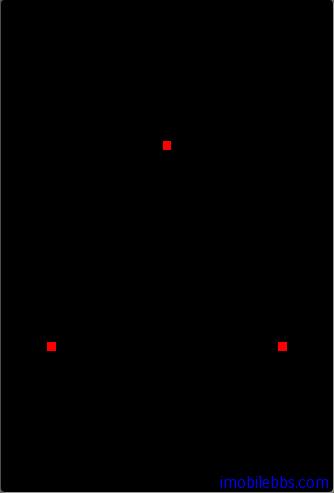上一篇介绍了OpenGL ES能够绘制的几种基本几何图形:点,线,三角形。将分别介绍这几种基本几何图形的例子。为方便起见,暂时在同一平面上绘制这些几何图形,在后面介绍完OpenGL ES的坐标系统和坐标变换后,再介绍真正的3D图形绘制方法。
在Android OpenGL ES 开发教程(7):创建实例应用OpenGLDemos程序框架 创建了示例应用的程序框架,并提供了一个“Hello World?示例。
为避免一些重复代码,这里定义一个所有示例代码的基类OpenGLESActivity,其定义如下:
public class OpenGLESActivity extends Activity
implements IOpenGLDemo{
/** Called when the activity is first created. */
@Override
public void onCreate(Bundle savedInstanceState) {
super.onCreate(savedInstanceState);
this.requestWindowFeature(Window.FEATURE_NO_TITLE);
getWindow().setFlags(
WindowManager.LayoutParams.FLAG_FULLSCREEN,
WindowManager.LayoutParams.FLAG_FULLSCREEN);
mGLSurfaceView = new GLSurfaceView(this);
mGLSurfaceView.setRenderer(new OpenGLRenderer(this));
setContentView(mGLSurfaceView);
}
public void DrawScene(GL10 gl) {
gl.glClearColor(0.0f, 0.0f, 0.0f, 0.0f);
// Clears the screen and depth buffer.
gl.glClear(GL10.GL_COLOR_BUFFER_BIT
| GL10.GL_DEPTH_BUFFER_BIT);
}
@Override
protected void onResume() {
// Ideally a game should implement onResume() and onPause()
// to take appropriate action when the activity looses focus
super.onResume();
mGLSurfaceView.onResume();
}
@Override
protected void onPause() {
// Ideally a game should implement onResume() and onPause()
// to take appropriate action when the activity looses focus
super.onPause();
mGLSurfaceView.onPause();
}
protected GLSurfaceView mGLSurfaceView;
}
- 在onCreate 方法中创建一个GLSurfaceView mGLSurfaceView,并将屏幕设置为全屏。并为mGLSurfaceView设置Render.
- onResume ,onPause 处理GLSurfaceView 的暂停和恢复。
- DrawScene 使用黑色清空屏幕。
OpenGL ES 内部存放图形数据的Buffer有COLOR ,DEPTH (深度信息)等,在绘制图形只前一般需要清空COLOR 和 DEPTH Buffer。
在屏幕上使用红色绘制3个点。创建一个DrawPoint 作为 OpenGLESActivity 的子类,并定义3个顶点的坐标:
public class DrawPoint extends OpenGLESActivity
implements IOpenGLDemo{
float[] vertexArray = new float[]{
-0.8f , -0.4f * 1.732f , 0.0f ,
0.8f , -0.4f * 1.732f , 0.0f ,
0.0f , 0.4f * 1.732f , 0.0f ,
};
/** Called when the activity is first created. */
@Override
public void onCreate(Bundle savedInstanceState) {
super.onCreate(savedInstanceState);
}
...
}
下面为DrawPoint 的DrawScene 的实现:
public void DrawScene(GL10 gl) {
super.DrawScene(gl);
ByteBuffer vbb
= ByteBuffer.allocateDirect(vertexArray.length*4);
vbb.order(ByteOrder.nativeOrder());
FloatBuffer vertex = vbb.asFloatBuffer();
vertex.put(vertexArray);
vertex.position(0);
gl.glColor4f(1.0f, 0.0f, 0.0f, 1.0f);
gl.glPointSize(8f);
gl.glLoadIdentity();
gl.glTranslatef(0, 0, -4);
gl.glEnableClientState(GL10.GL_VERTEX_ARRAY);
gl.glVertexPointer(3, GL10.GL_FLOAT, 0, vertex);
gl.glDrawArrays(GL10.GL_POINTS, 0, 3);
gl.glDisableClientState(GL10.GL_VERTEX_ARRAY);
}
- 首先是使用FloatBuffer 存放三个顶点坐标。
- 使用glColor4f(float red, float green, float blue, float alpha) 将当前颜色设为红色。
- glPointSize(float size) 可以用来设置绘制点的大小。
- 使用glEnableClientState 打开Pipeline 的Vectex 顶点“开关”
- 使用glVertexPointer 通知OpenGL ES图形库顶点坐标。
- 使用GL_POINTS 模式使用glDrawArrays绘制3个顶点。
 下载
下载